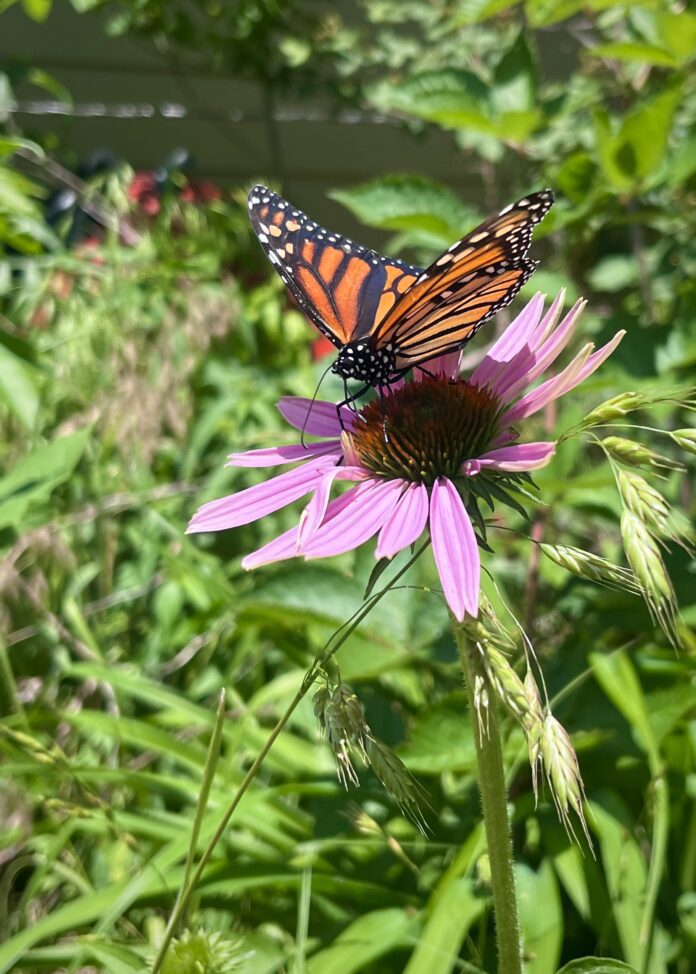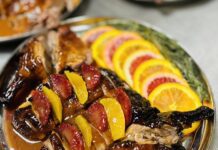
Oklahoma plays a key role in monarch butterfly migrations in both spring and fall. The peak of their autumnal migration typically occurs in late September and early October — so you’ll be able to see them in flight soon.
“Monarch butterflies have been making this incredible migration for thousands of years, a journey that spans up to 3,000 miles across North America,” says Stefanie Leland, director of marketing and communications at the Oklahoma Monarch Society. “Oklahoma is centrally located right in the heart of their migratory pathway, making our state a vital stopover for these butterflies.”
Janet Horner, a Canadian County Master Gardener and past president, is also a 2018 Certified Monarch Hero, a 2024 Certified Pollinator Steward, and lead for the BlueSTEM Pollinator Garden and Monarch Waystation at Fort Reno. Horner and her husband raise monarchs from eggs in their own garden, and participate in monarch tagging events in Canadian, Kingfisher and Oklahoma counties.
Horner says during the spring, monarchs fly from “their overwintering sites in Mexico through Oklahoma. The females lay eggs on milkweed. During the fall migration, the super generation of monarchs make the return trip through Oklahoma back to Mexico for the winter. It’s vital to their survival for Oklahomans to provide lots of nectar sources for them. They store fat — nectar — to survive the winter in Mexico.”
Leland continues: “The monarch migration is important to Oklahoma’s ecosystem because monarchs contribute to the pollination of native plants. as they feed on nectar during their journey, supporting biodiversity and healthy plant communities.”
In short, the importance of monarch butterflies can’t be overstated.
“Monarchs serve as an indicator of ecosystem health, in that declining monarch numbers can signal broader environmental issues with not just monarchs, but our native bees, moths and other insects we rely on for pollinating our crops,” says Leland. “In addition, the native plants that monarchs rely on, such as milkweed and wildflowers, provide critical resources for many other pollinators and wildlife species. Monarchs also serve as an ambassador for other species, drawing attention to the importance of protecting habitats and ecosystems that support a diversity of life across Oklahoma.”
Horner adds that monarchs are a source of food for some birds and insects, and they help in the reproduction of wildflowers, vegetables and fruits.
To help monarchs, Horner stresses the importance of “having lots of fall blooming annuals and perennials like goldenrods, asters, sunflowers, blue mistflower and zinnias.”
Because monarch populations are declining, Leland says it’s important to help them during their migration. She says to avoid harmful chemicals, including spraying for mosquitoes with toxic chemicals, and adds that monarchs “need milkweed, which is their host plant and the only plant their caterpillars can eat. A great place to find plants they need is found at
okiesformonarchs.org.”
Where to Spot the Monarchs
This fall, Horner says the public may see monarchs mainly along the I-35 corridor. Plus, a variety of parks, gardens and businesses hold monarch-centric fall festivals, including OKC’s Myriad Botanical Gardens, Tulsa’s Monarchs on the Mountains, Yukon’s Molly Spencer Farms, and Claremore’s Will Rogers Park.
Leland adds that fans may spot monarchs “nectaring in gardens, roosting overnight in trees or flying in a strong directional manner. Look for clusters of butterflies in trees, especially during the evening as they settle in for the night.”
Main image cutline: A monarch lands on a coneflower during its annual migration. Photo by Stefanie Leland courtesy the Oklahoma Monarch Society























